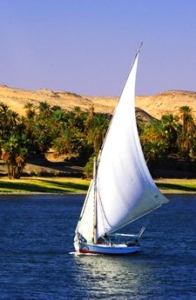Nile River
The Nile: Africa’s Longest River
The Nile, flowing north through northeastern Africa, is the undisputed longest river in the continent. Despite claims that the Amazon River surpasses it in length, the Nile remains the world’s longest at approximately 6,650 kilometers (4,130 miles).The Nile is a remarkable river, flowing northward through the heart of Africa.weaving together a tapestry of diverse cultures, rich histories, and astounding natural beauty.
Tributaries and Origins
The Nile is formed by the confluence of two major tributaries: the White Nile and the Blue Nile. The White Nile, considered the headwaters, originates in the Great Lakes region and traverses Tanzania, Lake Victoria, Uganda, and South Sudan. The Blue Nile, on the other hand, originates from Lake Tana in Ethiopia and provides 80% of the Nile’s water and sediment.
Geography and Importance of Nile river
The Nile’s northern section flows through the Sudanese desert into Egypt, where it forms a vast delta before emptying into the Mediterranean Sea. For centuries, the river has been a lifeline for Egyptian and Sudanese civilizations, supporting population centers, agriculture, and cultural heritage.
Etymology and Names of Nile
The name Nile derives from the ancient Egyptian word “Iteru,” meaning “river.” In Coptic, it is known as “piaro,” while in Nobiin, it is called “Áman Dawū” (the great water).
Source Controversy of Nile river
While Lake Victoria is often considered the source of the Nile, there is ongoing debate about its true origin. The Kagera River, which feeds Lake Victoria, has several significant tributaries, and it is unclear which of these is the most distant.
Water Sharing Disputes of Nile
The Nile’s water resources have been a source of political tension for decades. Egypt, Ethiopia, and other nations have expressed concerns about the equitable distribution of water. The Nile Basin Initiative aims to promote cooperation and prevent conflicts over water rights.
Egypt and Nile river :
Ancient Egypt, in particular, owed much of its prosperity and cultural development to the Nile. The river’s annual flood cycle deposited nutrient-rich silt onto the fertile banks, allowing for the cultivation of crops and the support of a burgeoning population. This reliable source of water and fertile land facilitated the rise of a complex society, characterized by monumental architecture, advanced agricultural practices, and a rich cultural heritage.
If you willing one day to have special experience along Nile of Egypt check this link here
Written by ATW Updated June 2024






